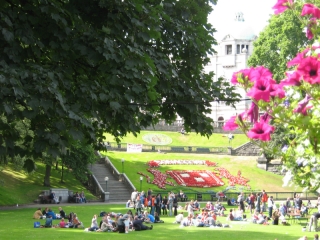TIF – doesn’t this American innovation in borrowing just sound fantastic? You get to ‘unlock’ money, re-develop an area, and money comes flooding in. What could be wrong with that? Karin Flavill looks across the pond to the home of the junk bond and bad mortgages, and doesn’t like what she sees.
While arguments rage over the future of Union Terrace Gardens, there’s consensus about one thing. Tax Increment Funding is a somewhat difficult concept to get to grips with. Not because the basic definition is complex.
TIF funds development by borrowing against future business tax gains arising as a consequence of that development. New developments mean new business rates. The local authority keeps a portion of those business rates (from businesses that wouldn’t have moved into the area but for the development) to repay the loan.
The complexity arises in assessing how this mechanism can be applied in a manner that avoids various potential pitfalls. TIF is still very much in the experimental stages in the UK, so we lack a domestic reference point to understand how well the process is likely to work from start to finish.
When business is attracted from one area to another by a TIF funded development, it may be at the expense of another area. This is known as “displacement”. The area benefiting from TIF is pleased to lure business away with its spanking new TIF-funded development. The region losing out wants some protection against financial detriment.
The TIF scheme provides that tax increment coming at the expense of another region can’t be retained by the local authority to make TIF repayments. Like other NDRs, those increments must be sent to Central Government who will pool them with other funds then redistribute the funds equitably among regions.
Rather than being a tool to give cities a competitive edge and win City of Culture status for celebrated developments (the vision currently being promoted in CGP supporters’ referendum campaigns), TIF was first developed in the US as a means of helping regions to improve their most blighted areas. Gradual shifts away from this philosophy, and increasingly creative ways of arguing blight, have led to many states in the US tightening up legislation to prevent TIF from being awarded except where genuine blight is demonstrated.
Chicago is often cited as example of the TIF scheme being misused to benefit the areas that least need it. In August last year, a report was released outlining areas for improvement in the operation of TIF in that city. The report highlighted problems regarding the monitoring of TIF expenditure.
Taxpayers had not been afforded easy access to information that would help them understand the TIF process or to evaluate the performance of the investment. This reduced transparency of the process.
although the initial cost proposed was $224.3 million, ultimately the park cost $482.4 million
The harder it is for the ordinary citizen to understand the TIF process and to evaluate the success of the development it funds, the greater the potential for corruption and abuse of the process by those who do understand it, and who can make it work to their own advantage.
That some will seek and gain an advantage through cronyism is an unfortunate element of life from which no city is immune.
In the 1990s, Chicago Mayor Daley (no relation to Arthur) developed a strong attachment to a project that would come to be known as Millennium Park. A 16-acre landscape situated over an underground parking structure, it was built on top of Railroad tracks in an existing park called Grant Park. The architect involved was Frank Gehry who had won international acclaim for the Guggenheim Museum in Bilbao. The Chicago Tribune enthused that:
“The most celebrated architect in the world may soon have a chance to bring Chicago into the 21st Century”.
The park has certainly won many admirers worldwide and is, in many ways, an excellent model for what the City Garden supporters are hoping that project will become. Properties in the immediate surrounds have become very fashionable and have increased significantly in value.
For others there has been a hefty price tag. For example, although the initial cost proposed was $224.3 million, ultimately the park cost $482.4 million. The park has come at a very high price to Chicago residents in terms of cuts to funding of public services and job cuts that were necessitated by the cost of the park. Salt is rubbed into the wound, on occasion, when the park is closed to the public so that corporate functions may be held there.
During and after the building of the park, Mayor Daley was frequently criticised for alleged cronyism in the awarding of contracts. Other areas of the city continued to deteriorate, while their inhabitants observed the increasing wealth and prosperity of those parts of the city that benefited from TIF funded schemes.
Areas that never suffered from true blight in the first place, but which were a focus of interest for developers, politicians, owners of business premises and others who could make the TIF scheme work for them.
In some ways it’s puzzling that we, supposedly a far more socialist nation than the US, are applying a model of TIF so similar to that model which states in the US have been increasingly trying to move away from by drafting legislation that aims to help TIF function in accordance with its original aims.
There has always been a tendency for conservatives to condemn the poor for their reliance on state sponsored welfare, but in recent years have people started questioning more vigorously the exploitation of taxpayer financed schemes by the some of the biggest players in business (players who have traditionally, but not always accurately, been lauded for their self-sufficiency).
TIF deserves close attention for its potential to increase this problem. Failure to know, or care about, the original philosophy of TIF leaves us less alert to its potential for misuse that could worsen existing inequalities in our society.
The UK version of TIF springs from recommendations in a 2008 report by PWC and Core Group Cities for an alternative method of funding developments in core group cities (the 8 largest regional cities in England). The report is here.
It begins with commentary on the economic successes of the core group cities, and highlights continuing problems relating to unemployment and deprivation in some neighbourhoods. It states an aim to “rejuvenate communities, provide new employment opportunities and stimulate further economic growth.”
Promoters of the CGP dismiss the possibility of serious overspending as scaremongering
The report then discusses the increasing political emphasis on a devolved approach to economic development . A defining aspect of TIF is that it permits local authorities greater autonomy in the matter of funding developments once they have been granted the TIF loan.
For this to happen, they must submit a detailed business plan to the SFT who make recommendations to central government regarding feasibility.
PWC, having been involved in the UK version of TIF from its conception, is ideally positioned to assist local authorities with the preparation and submission of their business plans. Finance and Resources Committee meeting minutes from September 2010 discuss PWC’s remit in preparing a TIF business plan for approval by the SFT. The minutes refer to several important city projects the Council would wish to progress, whether or not the City Garden project went ahead.
See: https://docs.google.com …committees.aberdeencity …pwc+tif+business+plan
“The terms of PWC’s assignment make it clear that they are required to produce a business case that ensures zero financial risk for the Council.”
The Council states that it will make no financial contribution to the City Garden Project. The development must be funded wholly by private contributions and by the TIF loan and completed within the budget.
Promoters of the CGP dismiss the possibility of serious overspending as scaremongering. Chicago’s Millennium Park experience demonstrates, however, how this can and does happen. As a response to such concerns, Sir Ian Wood has pledged an extra £35 million. It’s not clear what will happen if the cost exceeds this.
Despite ACC’s insistence that PWC present a business case involving zero risk to the Council, the draft business case completed in January of this year contains no such promise. It focuses on minimising risk and balancing the risks involved in carrying out the project against the risks involved in doing nothing.
Outlining the need to attract investment and talented professionals to Aberdeen to assure future prosperity, the plan refers particularly to the energy industry. Due to the oil and gas industry being regarded as the primary targets for investment in Aberdeen, and Aberdeen’s existing status as the main centre in Scotland for this industry, PWC anticipate displacement being low (10%). A low anticipated displacement figure is essential for arguing the likely success of a business plan.
PWC appears to anticipate investment by that industry increasing in Aberdeen, alongside the increasing depletion of oil and gas reserves
Work is expected to be completed over a 5 year period beginning this year, with TIF borrowing being carried out in stages (the first draw down taking place in 2014). The proposed development is expected to create approximately 2 million square feet of commercial space and to speed up the development of a further 1.4 million square feet of commercial space.
The CCRS (City Centre Regeneration Scheme) predicts 6,500 new jobs resulting from the development. It should be noted, though, that that figure is a “by 2039” prediction.
The business plan states:
“Oil and gas reserves will run out over time, perhaps 30 years, and Aberdeen is looking ahead. It knows it needs to adapt its industrial base and re-examine how it creates wealth and prosperity. Aberdeen is confident it can do so.”
This project is to be completed in 2017, and its success relies significantly on a very low displacement figure of 10%. In presenting this figure PWC relies on the oil and gas industry, already present in Aberdeen (and therefore not being taken from other areas) being the main sources of increased investment in Aberdeen. Confusingly, PWC appears to anticipate investment by that industry increasing in Aberdeen, alongside the increasing depletion of oil and gas reserves in the North Sea.
Perhaps in anticipation of confusion about this assertion, much is made of the possibilities relating to renewable energy – an industry Aberdeen must embrace and develop expertise in, regardless of Donald Trump’s views. The question is whether developments in other areas area will not only compensate for the steadily diminishing presence of the oil industry, but expand to the point where the business plan can work as anticipated.
Regarding the City Garden proposed as a replacement for UTG, the report comments…
“While there is no direct benefit the fact that the City Gardens Project becomes a reality and underpins the CCRS will benefit Aberdeen’s wider population and business community.”
During a recent BBC Scotland debate, campaigner Mike Shepherd (a geologist with years of experience in, and expert knowledge of, the energy sector) was shouted down and jeered at by pro CGP hecklers. The latter have tended to define opponents of the City Garden Project as tree-huggers and luddites who will be crushed by the wheels of change. UTG has also been described, throughout the debate, as a dangerous area…despite police reports indicating far lower crime levels in UTG than in surrounding street level areas.
The debate has often been an acrimonious one, featuring conflicts of various kinds. Already the TIF pilot scheme in the UK form originally advocated by PWC has brought deep divisions to Aberdeen. It seems set to be promoting a cheerfully unapologetic attitude, amongst some in our community, with regard to social exclusion.
A popularly cited reason for getting rid of UTG is that this will also rid the city centre of people with drug and alcohol related problems. Presumably, relegating them to more blighted areas that would, were TIF being applied in a manner consistent with its original aims, be the areas actually benefiting from this scheme.










